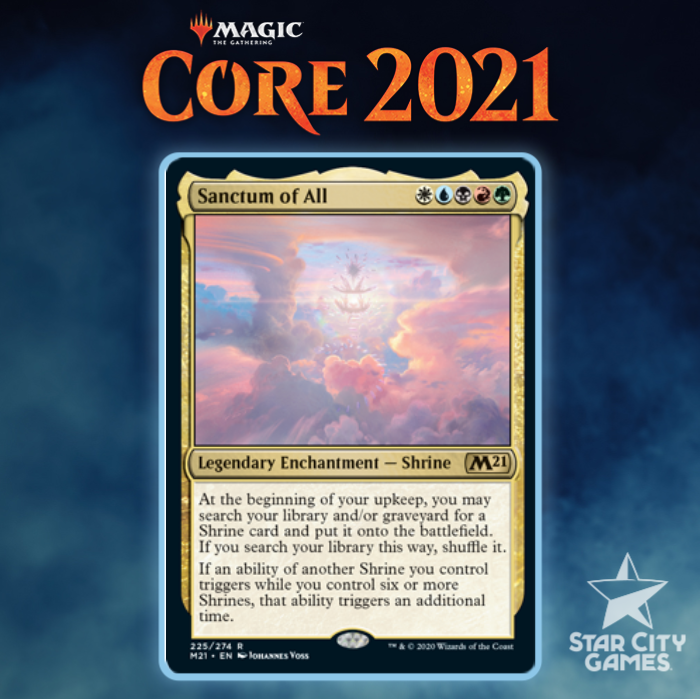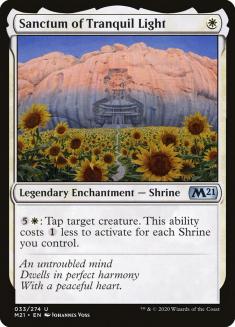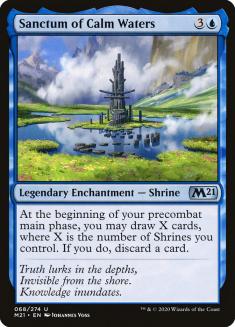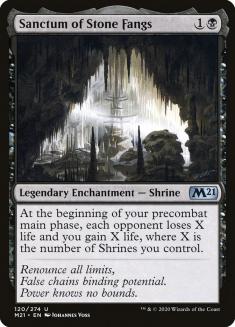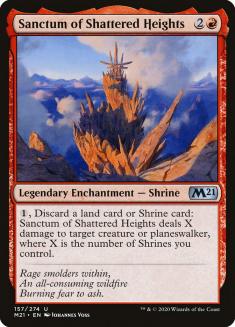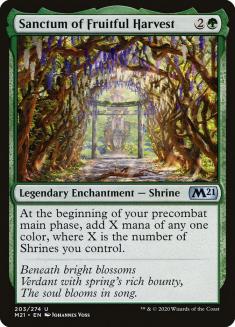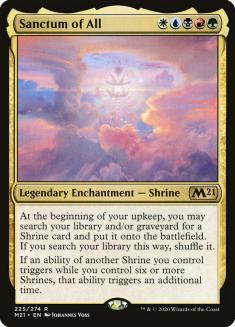Shrines are back!
This style of build-around is loved by many, but how good are Shrines in Draft? First, we need to assess the expectation of how often a player can draft a Shrine. To approximate this, I ran over one million simulations with the following logic:
- There is always one five-color Shrine drafter at the table. This drafter never passes a Shrine.
- The other seven drafters are randomly sampled from the color pairs with equal probability. There can be multiple drafters of the same color-pair. They only take on-color Shrines.
- The normal drafters never pass a Shrine if they already have one, and never take one in Pack 3 if there are zero in their pool.
- The normal drafters have some strategy for how they take Shrines. This strategy lessens (by 50% probability) in Pack 2 if there are zero Shrines drafted so far.
- I run this simulation with sixteen different metrics for the normal drafters. The table below describes the results. Think of 0 as “never take a Shrine,” 15 as “never pass a Shrine,” and 8 as a more nuanced “pick Shrines with increasing probability through Pick 8, and never pass them if they wheel.”
The numbers below are the average expected number of Shrines for a deck given the strategy of picking Shrines. There can, and will, be drafts where eight Shrines are opened. Maybe the Five-Color deck gets them all! But for the most part, these numbers are a reasonable ballpark to start thinking Shrines.
The following chart gives the expected number of Shrines (including duplicates) per player given their Shrine Strategy.
| Normal Strategy | Shrines for Five-Color | Shrines for Normal |
| 0 | 4.8425 | 0 |
| 1 | 4.4418 | 0.0599 |
| 2 | 4.1167 | 0.1041 |
| 3 | 3.8899 | 0.1419 |
| 4 | 3.6536 | 0.1742 |
| 5 | 3.5004 | 0.1993 |
| 6 | 3.3339 | 0.2193 |
| 7 | 3.2098 | 0.2407 |
| 8 | 3.0805 | 0.2585 |
| 9 | 2.985 | 0.266 |
| 10 | 2.8267 | 0.2864 |
| 11 | 2.7886 | 0.2974 |
| 12 | 2.7142 | 0.3115 |
| 13 | 2.6906 | 0.314 |
| 14 | 2.6457 | 0.3217 |
| 15 | 2.5752 | 0.3226 |
The important observation to take from this chart is that, regardless of the normal two-color strategy, the expected number of Shrines they will take is less than 0.33. And remember this is in the world where, regardless of strategy, players never pass an on-color Shrine once they already have one.
You might say that we could live in a world where the five-color deck doesn’t exist every Draft. I ran the numbers there too. In the world where the five-color deck doesn’t exist at all, the maximum expected number of Shrines for a two-color deck across all strategies is 0.57. The only way to get this number sufficiently large — note that it still will be well below 2.0 — is if a two-color player takes Shrines highly while all the other players do not. This scenario isn’t reasonable. This bodes well for that five-color deck, as it means Shrines should be evaluated standalone in two-color decks unless the player already has a Shrine in their pool. Luckily, that evaluation isn’t particularly difficult. So let’s look at the Shrines!
Shrines can range from backbreaking to underwhelming. Their value is not only deck-dependent but also format-dependent. Honden of Infinite Rage was one of the best uncommons in Eternal Masters. But so was Flame Jab. That format had such an abundance of one-toughness creatures that the card was fantastic without any other Shrines. Keep an eye of Sanctum of Shattered Heights for exactly the same reason.
Differentiating between synergy cards and generic good cards is an important skill and will have a significant impact on the value of each Shrine.
Card advantage is easy to grok when considering Divinations, but the majority of the time managing card economy isn’t about counting two-for-ones. Sanctum of Shattered Heights technically will rarely generate card advantage like Shrine of Infinite Rage. Requiring a land or Shrine to discard is actually card disadvantage. I think it will be common for players to see this card as a removal machine gun and take it highly. Unfortunately, discarding a card is a real cost. But don’t let that cost deter you from this Shrine. Turning excess lands and duplicates of Shrines into removal spells can yield a net-positive card economy.
The power of Sanctum of Shattered Heights will be a function of the density of one-toughness threats. If there aren’t many one-toughness creatures, Sanctum of Shattered Heights is below par outside of the Shrine deck.
Value in Generic Red Deck: 4/10
Value in Shrine Deck: 8.5/10
Note: Both of those numbers become noticeably higher if there are a lot of one-toughness creatures in this format.
Similar to Sanctum of Shattered Heights, Sanctum of Calm Waters is card disadvantage. However, we’ve seen repeatable looting effects before, and they are always quite good. Limited decks have a wide power band. The delta between the worst card and the best card is often stark. Looting every turn skews the distribution of power of Limited decks in a significant manner. While it’s not inherent card advantage, increasing the expected card quality in hand is game-winning.
I expect this Shrine to be an early pick. Every blue deck will play the card, although without additional Shrines, I would expect to sideboard it out against aggressive decks.
Value in Generic Deck: 6.5/10
Value in Shrine Deck: 8.5/10
This Shrine has the largest delta between standalone evaluation and Shrine evaluation. Draining one every turn is sideboard material at best. But historically, draining two every turn is backbreaking and extremely hard to beat (I’m looking at you, Palace Siege).
In the Shrine deck, this is probably the best possible Turn 2 play. It starts granting a life buffer early and provides immediate value for other Shrines on curve. While I expect the Shrine deck to be base Simic, I wouldn’t be surprised if multiple Sanctum of Stone Fangs should push toward a Golgari base. It likely doesn’t make a strong influence away from the classic build, but don’t write it off.
Value in Generic Deck: 2/10
Value in Shrine Deck: 9/10
Five mana is too steep a cost for a tap ability. This card has the potential to take over the game, but it’s impossible without a second Shrine. And still unlikely without a third. It’s probably a solid card for the Shrine deck, but even in that deck it doesn’t provide much value on its own. As the chart above shows, even the Shrine decks aren’t likely to have more than four Shrines, and this number includes duplicates. In that deck, it seems unlikely to have three Shrines on the battlefield. Two will be commonplace, but with two, Sanctum of Tranquil Light isn’t even that good.
Value in Generic Deck: 3/10
Value in Shrine Deck: 7/10
Similar to Sanctum of Calm Waters, Sanctum of Fruitful Harvest is just a good card. Most sets have a playable green three-mana ramp spell. This is that spell. While it only ramps for sorcery-speed plays, it also always provides the color needed on that turn. It also provides mana the turn it enters the battlefield, leading to less tempo-negative ramp turns.
Any green deck that’s splashing or has large creatures to play can happily include Sanctum of Fruitful Harvest as a solid, slightly-above-filler card. But the Shrine deck will go nuts for it. This deck is likely all about incremental value. It provides mana to cast spells drawn from Sanctum of Calm Waters. It means that Sanctum of Shattered Heights can throw away lands without worrying about being able to cast late-game spells. And it means that splashing is easy!
Value in Generic Deck: 6/10
Value in Shrine Deck: 9/10
This card is an achievement to chase in this set. That is all. Once in a blue moon, there will be the perfect five-color control deck that can afford to play this card because of a huge density of early interaction and also happens to have the uncommon Shrine from each color. Even then, it’s still so slow. I’m sure Sanctum of All will cause some crazy screenshots, but it’s best thought of as a meme.
Value in Generic Deck: 0/10
Value in Shrine Deck: MEME/10

